Impedance Acquisition of Proton Exchange Membrane Fuel Cell Using Deeper Learning Network
Abstract
:1. Introduction
- (1)
- In comparison to the LSTM previously employed, the residual network (ResNet) is utilized as the primary architecture for impedance estimation and can accomplish the purpose of higher estimated accuracy with satisfactory computational efficiency since it has strong feature extraction ability, and, on the other hand, introducing the residual construction can solve the degradation problem of the depth increment of traditional convolutional neural network (CNN) model.
- (2)
- In addition to the 2500 Hz impedance estimation for membrane water evaluation, the 10 Hz impedance, which characterizes the charge transfer process, is also estimated, assisting in the assessment of the reaction current density and internal oxygen concentration.
- (3)
- To further emphasize the estimated performance, the proposed method is validated and compared with CNN, LSTM, and other regression models against a series of test sequences. Moreover, the effectiveness and robustness of the proposed scheme in HFR and LFR estimation are evaluated under different noise levels and input signals.
2. Experimental Procedure and Data
2.1. Characteristic Frequency Selection
2.2. Input Parameter Selection
2.3. Data Set Organization
3. Impedance Estimation Framework
3.1. Data Processing
3.2. Model Framework
3.3. Model Implementation
4. Results and Discussion
4.1. Accuracy Comparison of Different Models
4.2. Model Robustness against Different Noise Levels
4.3. The Effect of Input Signal on Model Accuracy
4.4. Discussion
5. Conclusions
Author Contributions
Funding
Data Availability Statement
Conflicts of Interest
References
- Su, D.; Zheng, J.; Ma, J.; Dong, Z.; Chen, Z.; Qin, Y. Application of Machine Learning in Fuel Cell Research. Energies 2023, 16, 4390. [Google Scholar] [CrossRef]
- Reithuber, P.; Poimer, F.; Brandstätter, S.; Schutting, E.; Buchberger, S.; Trattner, A.; Eichlseder, H. Experimental Investigation of the Influence of NO on a PEM Fuel Cell System and Voltage Recovery Strategies. Energies 2023, 16, 3720. [Google Scholar] [CrossRef]
- Jiao, J.; Chen, F. Humidity estimation of vehicle proton exchange membrane fuel cell under variable operating temperature based on adaptive sliding mode observation. Appl. Energy 2022, 313, 118779. [Google Scholar] [CrossRef]
- Yuan, H.; Dai, H.; Wei, X.; Ming, P. Internal polarization process revelation of electrochemical impedance spectroscopy of proton exchange membrane fuel cell by an impedance dimension model and distribution of relaxation times. Chem. Eng. J. 2021, 418, 129358. [Google Scholar] [CrossRef]
- Yuan, H.; Tan, D.; Wei, X.; Dai, H. Fault Diagnosis of Fuel Cells by a Hybrid Deep Learning Network Fusing Characteristic Impedance. IEEE Trans. Transp. Electrif. 2023. [Google Scholar] [CrossRef]
- Lin, R.; Liu, D.; Xia, S.; Ma, T.; Dutruel, B. Stack shut-down strategy optimisation of proton exchange membrane fuel cell with the segment stack technology. Int. J. Hydrogen Energy 2020, 45, 1030–1044. [Google Scholar] [CrossRef]
- Choi, H.; Kim, J.; Kwon, O.; Yoo, H.; Kim, H.; Cha, H.; Park, T. Observation of flooding-induced performance enhancement in PEMFCs. Int. J. Hydrogen Energy 2022, 47, 6259–6268. [Google Scholar] [CrossRef]
- Moçotéguy, P.; Ludwig, B.; Beretta, D.; Pedersen, T. Study of the impact of reactants utilization on the performance of PEMFC commercial stacks by impedance spectroscopy. Int. J. Hydrogen Energy 2021, 46, 7475–7488. [Google Scholar] [CrossRef]
- Jeppesen, C.; Araya, S.S.; Sahlin, S.L.; Andreasen, S.J.; Kær, S.K. An EIS alternative for impedance measurement of a high temperature PEM fuel cell stack based on current pulse injection. Int. J. Hydrogen Energy 2017, 42, 15851–15860. [Google Scholar] [CrossRef] [Green Version]
- Ritzberger, D.; Striednig, M.; Simon, C.; Hametner, C.; Jakubek, S. Online estimation of the electrochemical impedance of polymer electrolyte membrane fuel cells using broad-band current excitation. J. Power Sources 2018, 405, 150–161. [Google Scholar] [CrossRef]
- Yuan, H.; Dai, H.; Ming, P.; Li, S.; Wei, X. A new insight into the effects of agglomerate parameters on internal dynamics of proton exchange membrane fuel cell by an advanced impedance dimension model. Energy 2022, 253, 124202. [Google Scholar] [CrossRef]
- Bullecks, B.; Suresh, R.; Rengaswamy, R. Rapid impedance measurement using chirp signals for electrochemical system analysis. Comput. Chem. Eng. 2017, 106, 421–436. [Google Scholar] [CrossRef]
- Lu, H.; Chen, J.; Yan, C.; Liu, H. On-line fault diagnosis for proton exchange membrane fuel cells based on a fast electrochemical impedance spectroscopy measurement. J. Power Sources 2019, 430, 233–243. [Google Scholar]
- Debenjak, A.; Boškoski, P.; Musizza, B.; Petrovčič, J.; Juričić, D. Fast measurement of proton exchange membrane fuel cell impedance based on pseudo-random binary sequence perturbation signals and continuous wavelet transform. J. Power Sources 2014, 254, 112–118. [Google Scholar] [CrossRef]
- Du, R.; Wang, X.; Dai, H.; Wei, X.; Ming, P. Online impedance spectrum measurement of fuel cells based on Morlet wavelet transform. Int. J. Hydrogen Energy 2021, 46, 24339–24352. [Google Scholar] [CrossRef]
- Yuan, H.; Du, R.; Wang, X.; Wei, X.; Dai, H. Advanced Online Broadband Impedance Spectrum Acquisition of Fuel Cells by S-Transform. IEEE Trans. Ind. Electron. 2023, 70, 3740–3750. [Google Scholar] [CrossRef]
- Heinzmann, M.; Weber, A.; Ivers-Tiffée, E. Advanced impedance study of polymer electrolyte membrane single cells by means of distribution of relaxation times. J. Power Sources 2018, 402, 24–33. [Google Scholar] [CrossRef]
- Ren, P.; Pei, P.; Li, Y.; Wu, Z.; Chen, D.; Huang, S.; Jia, X. Diagnosis of water failures in proton exchange membrane fuel cell with zero-phase ohmic resistance and fixed-low-frequency impedance. Appl. Energy 2019, 239, 785–792. [Google Scholar]
- Meyer, Q.; Liu, S.; Ching, K.; Da Wang, Y.; Zhao, C. Operando monitoring of the evolution of triple-phase boundaries in proton exchange membrane fuel cells. J. Power Sources 2023, 557, 232539. [Google Scholar]
- Xu, X.; Li, K.; Liao, Z.; Cao, J.; Wang, R. A Closed-Loop Water Management Methodology for PEM Fuel Cell System Based on Impedance Information Feedback. Energies 2022, 15, 7561. [Google Scholar] [CrossRef]
- Jiang, P.; Chen, J.; Jin, L.; Kumar, L. Adaptive Condition Monitoring for Fuel Cells Based on Fast EIS and Two-Frequency Impedance Measurements. IEEE Trans. Ind. Electron. 2023, 70, 8517–8525. [Google Scholar]
- Choi, H.; Jang, H.; Kim, J.; Kwon, O.; Yoo, H.; Cha, H.; Jeong, S.; So, Y.; Park, T. Real-time detection of flooding in polymer electrolyte membrane fuel cells using high-frequency electrochemical impedance. J. Power Sources 2023, 580, 233311. [Google Scholar]
- Wang, H.; Gaillard, A.; Hissel, D. A review of DC/DC converter-based electrochemical impedance spectroscopy for fuel cell electric vehicles. Renew. Energy 2019, 141, 124–138. [Google Scholar] [CrossRef]
- Tian, J.; Xiong, R.; Chen, C.; Wang, C.; Shen, W.; Sun, F. Simultaneous prediction of impedance spectra and state for lithium-ion batteries from short-term pulses. Electrochim. Acta 2023, 449, 142218. [Google Scholar]
- Guo, J.; Che, Y.; Pedersen, K.; Stroe, D.I. Battery impedance spectrum prediction from partial charging voltage curve by machine learning. J. Energy Chem. 2023, 79, 211–221. [Google Scholar]
- Ma, T.; Zhang, Z.; Lin, W.; Cong, M.; Yang, Y. Impedance prediction model based on convolutional neural networks methodology for proton exchange membrane fuel cell. Int. J. Hydrogen Energy 2021, 46, 18534–18545. [Google Scholar] [CrossRef]
- Lin, T.; Hu, L.; Wisely, W.; Gu, X.; Cai, J.; Litster, S.; Kara, L.B. Prediction of high frequency resistance in polymer electrolyte membrane fuel cells using long short term memory based model. Energy AI 2021, 3, 100045. [Google Scholar]
- Yuan, H.; Dai, H.; Ming, P.; Wang, X.; Wei, X. Quantitative analysis of internal polarization dynamics for polymer electrolyte membrane fuel cell by distribution of relaxation times of impedance. Appl. Energy 2021, 303, 117640. [Google Scholar]
- Yuan, H.; Dai, H.; Ming, P.; Zhao, L.; Tang, W.; Wei, X. Understanding dynamic behavior of proton exchange membrane fuel cell in the view of internal dynamics based on impedance. Chem. Eng. J. 2022, 431, 134035. [Google Scholar] [CrossRef]
- Lee, J.; Salihi, H.; Lee, J.; Ju, H. Impedance modeling for polymer electrolyte membrane fuel cells by combining the transient two-phase fuel cell and equivalent electric circuit models. Energy 2022, 239, 122294. [Google Scholar]
- Liu, X.; Peng, F.; Lou, G.; Wen, Z. Liquid water transport characteristics of porous diffusion media in polymer electrolyte membrane fuel cells: A review. J. Power Sources 2015, 299, 85–96. [Google Scholar] [CrossRef]
- Xing, L.; Das, P.K.; Song, X.; Mamlouk, M.; Scott, K. Numerical analysis of the optimum membrane/ionomer water content of PEMFCs: The interaction of Nafion® ionomer content and cathode relative humidity. Appl. Energy 2015, 138, 242–257. [Google Scholar]
- Yuan, H.; Dai, H.; Ming, P.; Zhan, J.; Wang, X.; Wei, X. A fuzzy extend state observer-based cascade decoupling controller of air supply for vehicular fuel cell system. Energy Convers. Manag. 2021, 236, 114080. [Google Scholar] [CrossRef]
- He, K.; Zhang, X.; Ren, S.; Sun, J. Deep Residual Learning for Image Recognition. In Proceedings of the 2016 IEEE Conference on Computer Vision and Pattern Recognition (CVPR), Las Vegas, NV, USA, 27–30 June 2016; pp. 770–778. [Google Scholar]
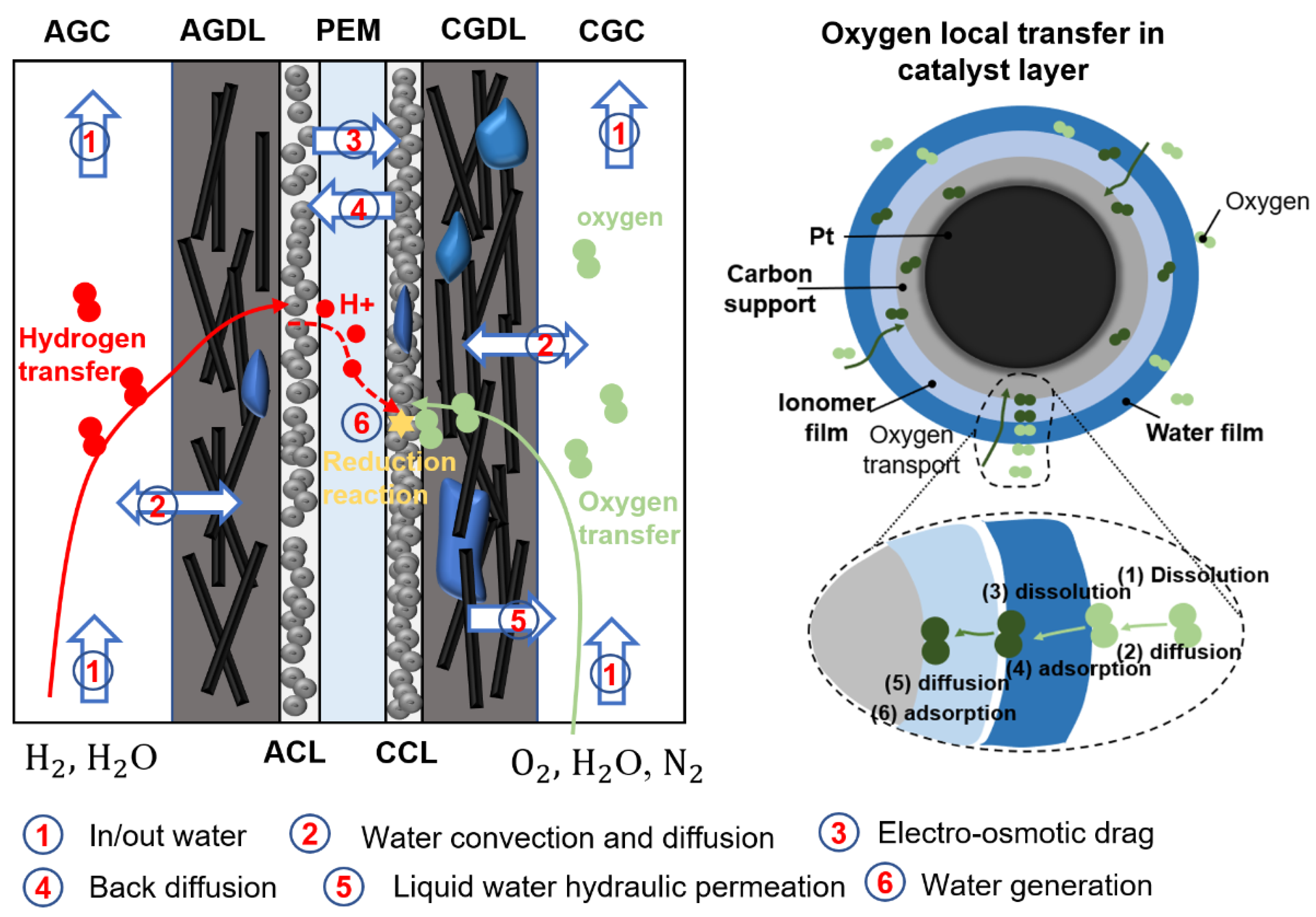
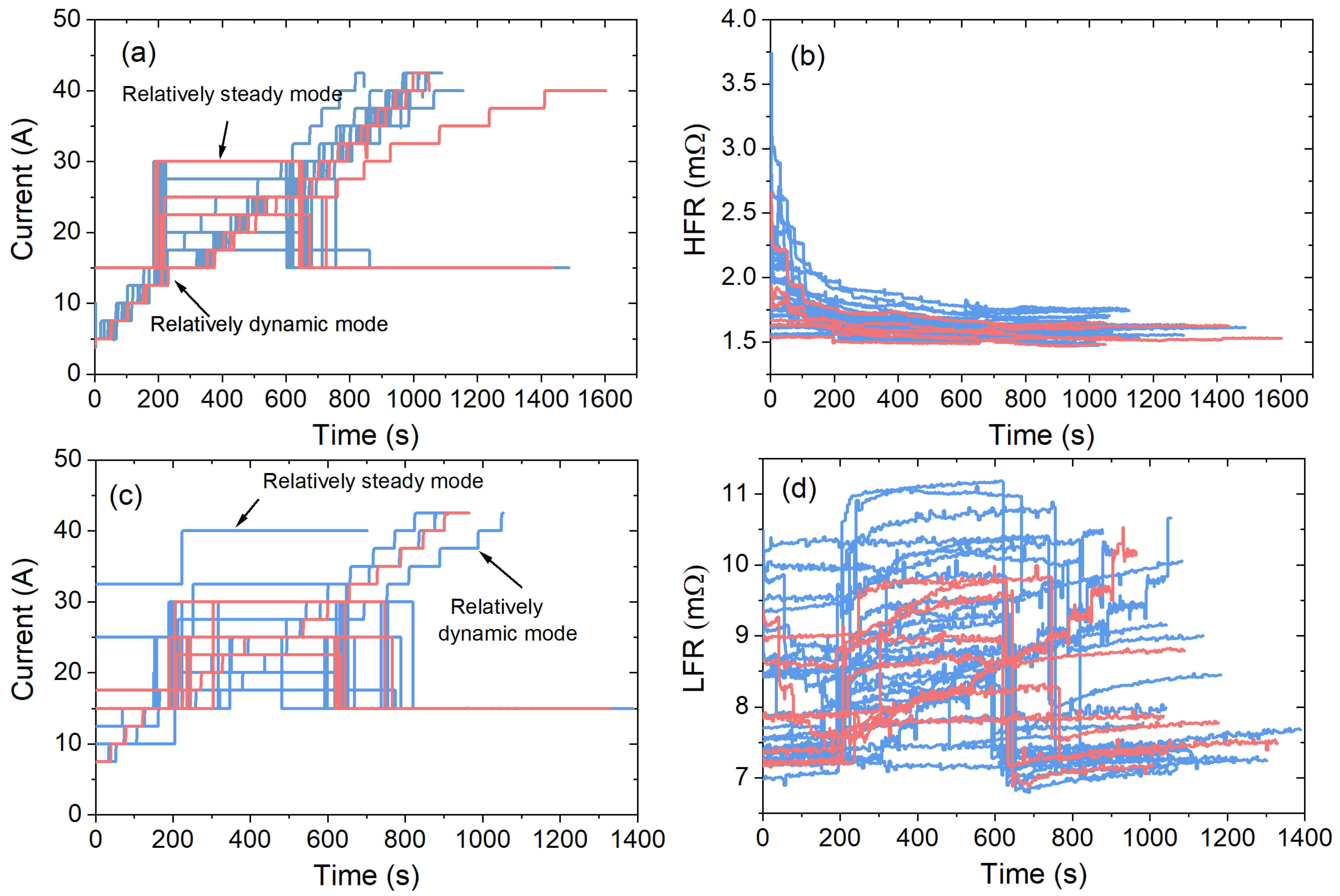
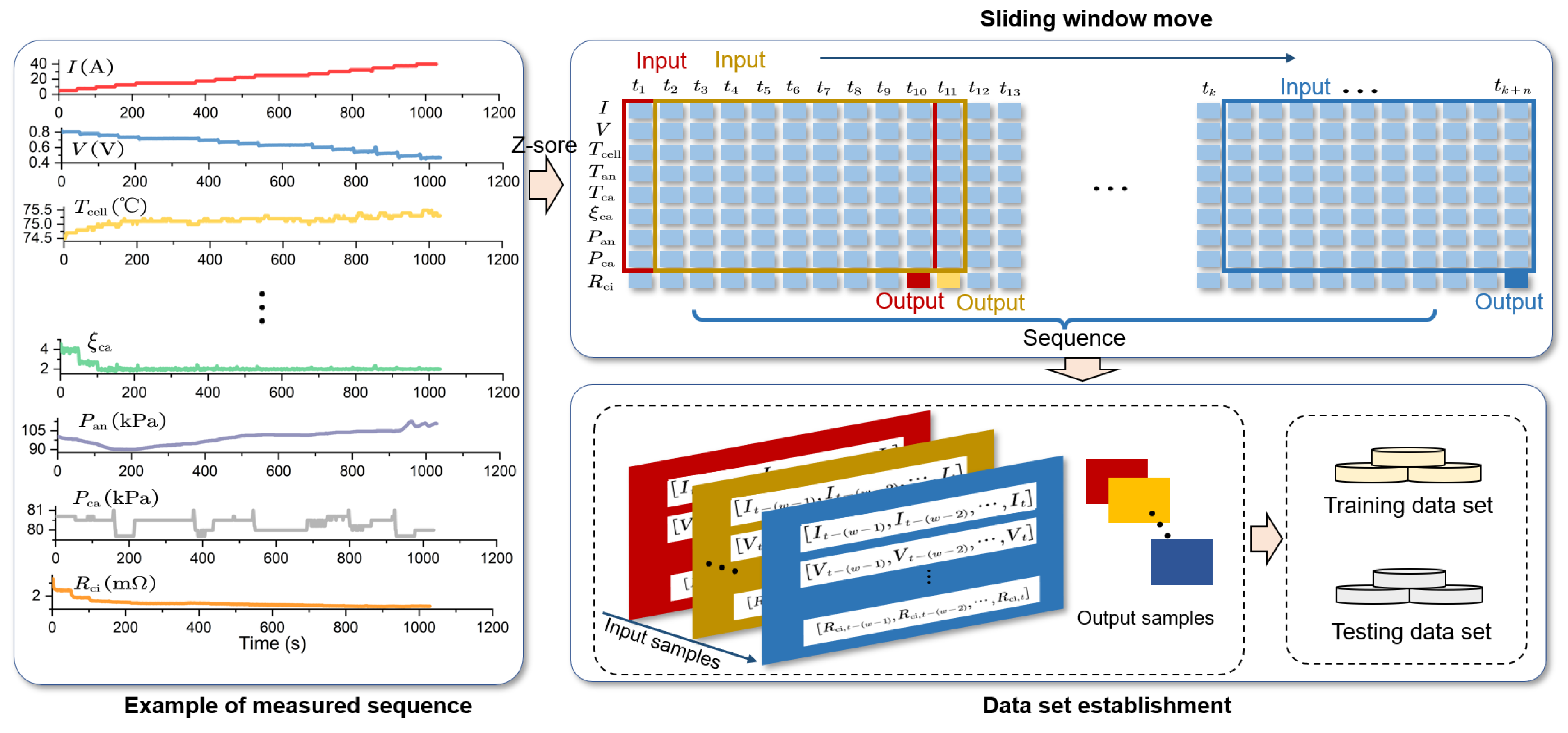
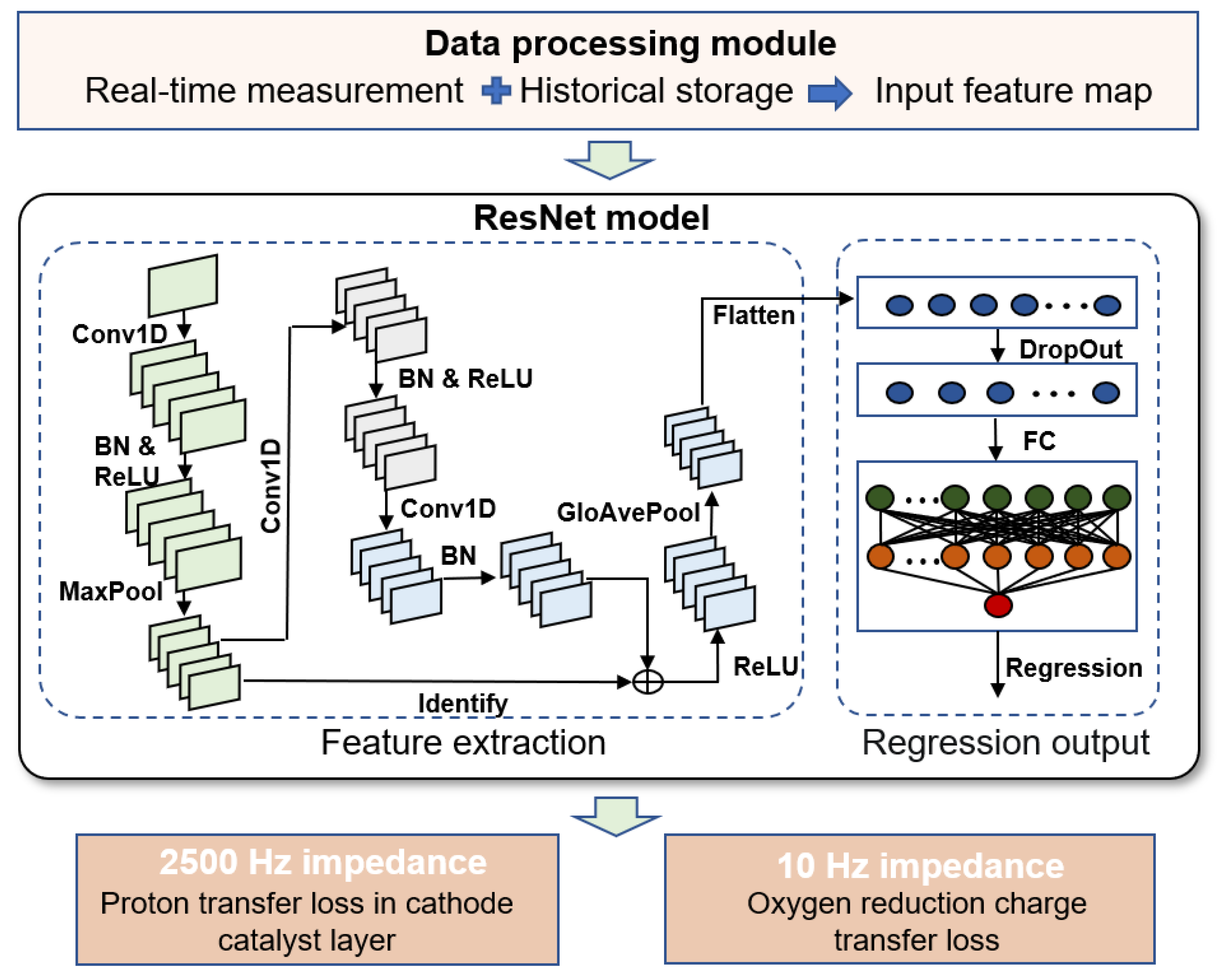

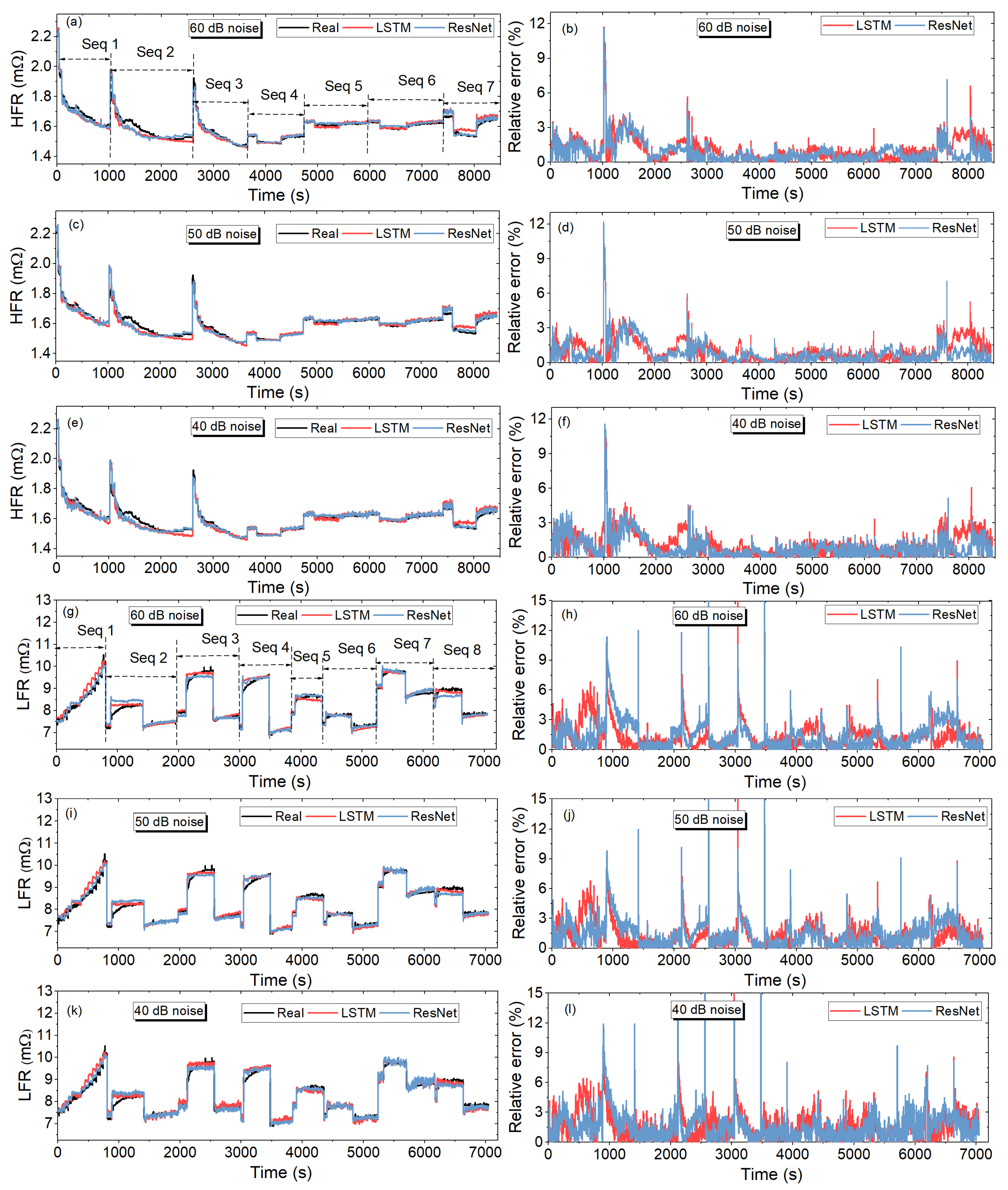


| Order | Detailed Information |
|---|---|
| 1 | Convolution layer (Kernel size: 5; Channel: 128; Padding; Step size 1) |
| 2 | Batch normalization layer |
| 3 | ReLU activation layer |
| 4 | Maximum pooling (residual connection is performed with order 9) |
| 5 | Convolution layer (Kernel size: 5; Channel: 128; Padding; Step size 1) |
| 6 | Batch normalization layer |
| 7 | ReLU activation layer |
| 8 | Convolution layer (Kernel size: 5; Channel: 128; Padding; Step size 1) |
| 9 | Batch normalization layer (residual connection is performed with order 4) |
| 10 | ReLU activation layer |
| 11 | Global average pooling layer |
| 12 | Flatten layer |
| 13 | Dropout layer (probability: 0.05) |
| 14 | Fully connected layer (Dense: 128) |
| 15 | Fully connected layer (Dense: 64) |
| 16 | Fully connected layer (Dense: 1) |
| Model | HFR Data Set | LFR Data Set | ||||
|---|---|---|---|---|---|---|
| Training Time | Testing Time | MAPE | Training Time | Testing Time | MAPE | |
| BP | 3709 s | 0.121 s | 6.984% | 2895 s | 0.200 s | 5.616% |
| SVR | 4970 s | 1.726 s | 4.811% | 1818 s | 0.983 s | 4.759% |
| CNN1d | 536 s | 6.478 s | 0.823% | 379 s | 5.126 s | 1.689% |
| CNN2d | 2404 s | 5.937 s | 1.193% | 1637 s | 4.934 s | 2.071% |
| LSTM | 288 s | 3.600 s | 1.042% | 161 s | 2.411 s | 1.446% |
| ResNet | 376 s | 6.132 s | 0.802% | 238 s | 4.822 s | 1.386% |
| Excluded Signal | HFR Data Set | LFR Data Set | ||
|---|---|---|---|---|
| LSTM | ResNet | LSTM | ResNet | |
| I | 1.642% | 1.380% | 2.026% | 1.797% |
| V | 1.573% | 1.545% | 2.862% | 2.299% |
| 1.093% | 1.077% | 1.464% | 1.510% | |
| 1.074% | 1.033% | 1.464% | 1.445% | |
| 1.183% | 1.101% | 2.393% | 1.741% | |
| 2.065% | 1.994% | 1.481% | 1.438% | |
| 1.055% | 1.037% | 1.447% | 1.423% | |
| 1.065% | 1.018% | 1.508% | 1.430% | |
Disclaimer/Publisher’s Note: The statements, opinions and data contained in all publications are solely those of the individual author(s) and contributor(s) and not of MDPI and/or the editor(s). MDPI and/or the editor(s) disclaim responsibility for any injury to people or property resulting from any ideas, methods, instructions or products referred to in the content. |
© 2023 by the authors. Licensee MDPI, Basel, Switzerland. This article is an open access article distributed under the terms and conditions of the Creative Commons Attribution (CC BY) license (https://creativecommons.org/licenses/by/4.0/).
Share and Cite
Xie, J.; Yuan, H.; Wu, Y.; Wang, C.; Wei, X.; Dai, H. Impedance Acquisition of Proton Exchange Membrane Fuel Cell Using Deeper Learning Network. Energies 2023, 16, 5556. https://doi.org/10.3390/en16145556
Xie J, Yuan H, Wu Y, Wang C, Wei X, Dai H. Impedance Acquisition of Proton Exchange Membrane Fuel Cell Using Deeper Learning Network. Energies. 2023; 16(14):5556. https://doi.org/10.3390/en16145556
Chicago/Turabian StyleXie, Jiaping, Hao Yuan, Yufeng Wu, Chao Wang, Xuezhe Wei, and Haifeng Dai. 2023. "Impedance Acquisition of Proton Exchange Membrane Fuel Cell Using Deeper Learning Network" Energies 16, no. 14: 5556. https://doi.org/10.3390/en16145556





